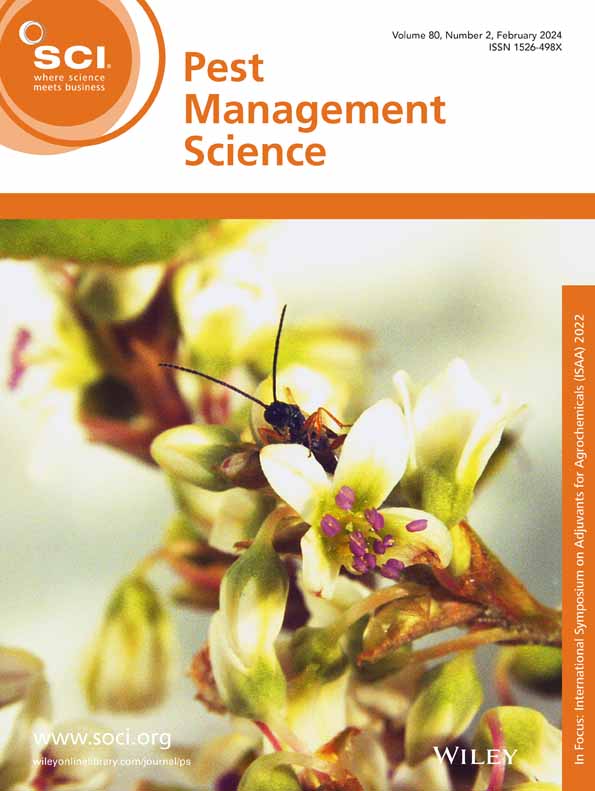Silicon nutrition enhances CYP450s‐ and GST‐mediated metabolism of sulfosulfuron in wheat and an invasive weed, Hordeum vulgare subsp. spontaneum
IF 3.8
1区 农林科学
Q1 AGRONOMY
Akbar Aliverdi, Ali Asghar Chitband
求助PDF
{"title":"Silicon nutrition enhances CYP450s‐ and GST‐mediated metabolism of sulfosulfuron in wheat and an invasive weed, Hordeum vulgare subsp. spontaneum","authors":"Akbar Aliverdi, Ali Asghar Chitband","doi":"10.1002/ps.8818","DOIUrl":null,"url":null,"abstract":"BACKGROUNDAlthough silicon nutrition in crops has been reported to improve growth and herbicide tolerance, the response of crop‐associated weeds has not been studied.RESULTSIn glasshouse studies, co‐applying potassium silicate (K<jats:sub>2</jats:sub>SiO<jats:sub>3</jats:sub>) + silicate‐solubilizing bacteria (SSB) synergistically increased wheat and spontaneous barley's silicon content by 2.2‐ and 2.6‐fold, respectively. Based on the median effective dose, it increased wheat (2.2–2.8‐fold) and spontaneous barley (3.5–3.7‐fold) tolerance to sulfosulfuron. With/without silicon nutrition, pretreating plant species with malathion or 4‐chloro‐7‐nitrobenzofurazan made them more sensitive to sulfosulfuron. Without silicon nutrition, cytochrome P450 reductase (1.3 <jats:italic>versus</jats:italic> 0.7 U g<jats:sup>−1</jats:sup>), glutathione S‐transferase (1.7 <jats:italic>versus</jats:italic> 1.2 U g<jats:sup>−1</jats:sup>), superoxide dismutase (23.7 <jats:italic>versus</jats:italic> 14.5 U mg<jats:sup>−1</jats:sup>), and catalase (412.9 <jats:italic>versus</jats:italic> 311.5 U mg<jats:sup>−1</jats:sup>) were more active in wheat than in spontaneous barley. All enzymes became more active with silicon nutrition, the increase was higher in spontaneous barley. Field studies conducted at two locations showed that without silicon nutrition and sulfosulfuron, spontaneous barley reduced wheat grain yield by 36.8–41.5%. Without sulfosulfuron, co‐applying K<jats:sub>2</jats:sub>SiO<jats:sub>3</jats:sub> + SSB synergistically increased spontaneous barley biomass by 37.4–76.1%, reducing wheat grain yield by 59.0–62.1%. Without silicon nutrition, sulfosulfuron (40 g ha<jats:sup>−1</jats:sup>) controlled spontaneous barley by 71.8–98.5%. Furthermore, it controlled spontaneous barley by 18.7–29.9% when K<jats:sub>2</jats:sub>SiO<jats:sub>3</jats:sub> + SSB was co‐applied.CONCLUSIONSilicon nutrition made both plants more tolerant to sulfosulfuron due to the increased activity of enzymes that metabolize herbicides and scavenge reactive oxygen species. It should be avoided in spontaneous barley‐infested wheat fields because it is more beneficial for spontaneous barley and reduces sulfosulfuron efficacy. © 2025 Society of Chemical Industry.","PeriodicalId":218,"journal":{"name":"Pest Management Science","volume":"13 1","pages":""},"PeriodicalIF":3.8000,"publicationDate":"2025-04-21","publicationTypes":"Journal Article","fieldsOfStudy":null,"isOpenAccess":false,"openAccessPdf":"","citationCount":"0","resultStr":null,"platform":"Semanticscholar","paperid":null,"PeriodicalName":"Pest Management Science","FirstCategoryId":"97","ListUrlMain":"https://doi.org/10.1002/ps.8818","RegionNum":1,"RegionCategory":"农林科学","ArticlePicture":[],"TitleCN":null,"AbstractTextCN":null,"PMCID":null,"EPubDate":"","PubModel":"","JCR":"Q1","JCRName":"AGRONOMY","Score":null,"Total":0}
引用次数: 0
引用
批量引用
Abstract
BACKGROUNDAlthough silicon nutrition in crops has been reported to improve growth and herbicide tolerance, the response of crop‐associated weeds has not been studied.RESULTSIn glasshouse studies, co‐applying potassium silicate (K
2 SiO
3 ) + silicate‐solubilizing bacteria (SSB) synergistically increased wheat and spontaneous barley's silicon content by 2.2‐ and 2.6‐fold, respectively. Based on the median effective dose, it increased wheat (2.2–2.8‐fold) and spontaneous barley (3.5–3.7‐fold) tolerance to sulfosulfuron. With/without silicon nutrition, pretreating plant species with malathion or 4‐chloro‐7‐nitrobenzofurazan made them more sensitive to sulfosulfuron. Without silicon nutrition, cytochrome P450 reductase (1.3
versus 0.7 U g
−1 ), glutathione S‐transferase (1.7
versus 1.2 U g
−1 ), superoxide dismutase (23.7
versus 14.5 U mg
−1 ), and catalase (412.9
versus 311.5 U mg
−1 ) were more active in wheat than in spontaneous barley. All enzymes became more active with silicon nutrition, the increase was higher in spontaneous barley. Field studies conducted at two locations showed that without silicon nutrition and sulfosulfuron, spontaneous barley reduced wheat grain yield by 36.8–41.5%. Without sulfosulfuron, co‐applying K
2 SiO
3 + SSB synergistically increased spontaneous barley biomass by 37.4–76.1%, reducing wheat grain yield by 59.0–62.1%. Without silicon nutrition, sulfosulfuron (40 g ha
−1 ) controlled spontaneous barley by 71.8–98.5%. Furthermore, it controlled spontaneous barley by 18.7–29.9% when K
2 SiO
3 + SSB was co‐applied.CONCLUSIONSilicon nutrition made both plants more tolerant to sulfosulfuron due to the increased activity of enzymes that metabolize herbicides and scavenge reactive oxygen species. It should be avoided in spontaneous barley‐infested wheat fields because it is more beneficial for spontaneous barley and reduces sulfosulfuron efficacy. © 2025 Society of Chemical Industry.
硅营养增强小麦和入侵杂草Hordeum vulgare subsp中cyp450和GST介导的硫代磺隆代谢。spontaneum
虽然硅营养已被报道可以改善作物的生长和对除草剂的耐受性,但对作物相关杂草的反应尚未研究。结果在温室研究中,共施用硅酸钾(K2SiO3) +硅酸盐溶菌(SSB)可使小麦和大麦的硅含量分别协同提高2.2倍和2.6倍。根据中位有效剂量,它增加了小麦(2.2-2.8倍)和大麦(3.5-3.7倍)对硫代磺隆的耐受性。在有/没有硅营养的情况下,用马拉硫磷或4‐氯‐7‐硝基苯并呋喃赞预处理植物物种,使它们对硫代磺隆更敏感。在没有硅营养的情况下,小麦中的细胞色素P450还原酶(1.3比0.7 U g−1)、谷胱甘肽S转移酶(1.7比1.2 U g−1)、超氧化物歧化酶(23.7比14.5 U mg−1)和过氧化氢酶(412.9比311.5 U mg−1)比天然大麦中的活性更高。各酶活性随硅营养的增加而增加,其中自发大麦的增加幅度更大。在两个地点进行的田间研究表明,在没有硅营养和磺胺磺隆的情况下,自发大麦使小麦籽粒产量降低36.8-41.5%。在不使用磺胺磺隆的情况下,共施用K2SiO3 + SSB可使大麦自发生物量增加37.4% ~ 76.1%,使小麦籽粒产量降低59.0% ~ 62.1%。在没有硅营养的情况下,硫代磺隆(40 g ha - 1)对大麦的自发性控制为71.8-98.5%。此外,当K2SiO3 + SSB共施时,它对大麦的自发性控制率为18.7-29.9%。结论硅营养增加了植物体内代谢除草剂和清除活性氧的酶的活性,使两种植物对硫代磺隆的耐受性增强。在天然大麦侵染的麦田应避免使用,因为它对天然大麦更有利,而且会降低磺胺磺隆的药效。©2025化学工业协会。
本文章由计算机程序翻译,如有差异,请以英文原文为准。


 求助内容:
求助内容: 应助结果提醒方式:
应助结果提醒方式:


